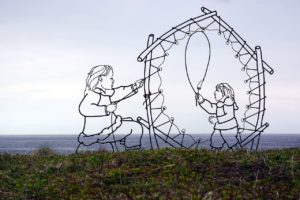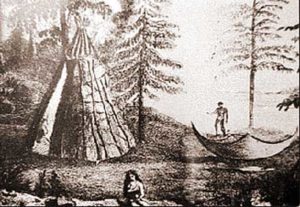Labrador is the easternmost part of the Canadian Shield, a vast area of ancient metamorphic rock comprising much of northeastern North America. Colliding tectonic plates have shaped much of the geology of Newfoundland. Gros Morne National Park has a reputation as an outstanding example of tectonics at work, and as such has been designated a World Heritage Site. The Long Range Mountains on Newfoundland’s west coast are the northeasternmost extension of the Appalachian Mountains.
History:
Early History:
Human habitation in Newfoundland and Labrador can be traced back about 9,000 years. The Maritime Archaic peoples were groups of Archaic cultures of sea-mammal hunters in the subarctic. They prospered along the Atlantic Coast of North America from about 7000 BC to 1500 BC. Their settlements included longhouses and boat-topped temporary or seasonal houses. They engaged in long-distance trade, using as currency white chert, a rock quarried from northern Labrador to Maine. The southern branch of these people was established on the north peninsula of Newfoundland by 5,000 years ago. The Maritime Archaic period is best known from a mortuary site in Newfoundland at Port au Choix.

The Maritime Archaic peoples were gradually displaced by people of the Dorset culture (Late Paleo-Eskimo) who also occupied Port au Choix. The number of their sites discovered on Newfoundland indicates they may have been the most numerous group of Aboriginal people to live there. They thrived from about 2000 BC to AD 800. Many of their sites were on exposed headlands and outer islands. They were more oriented to the sea than earlier peoples, and had developed sleds and boats similar to kayaks. They burned seal blubber in soapstone lamps.
The appearance of the Beothuk culture is believed to be the most recent cultural manifestation of peoples who first migrated from Labrador to Newfoundland around 1 AD. The Inuit, found mostly in Labrador, are the descendants of what anthropologists call the Thule people, who emerged from western Alaska around AD 1000 and spread eastwards across the High Arctic, reaching Labrador around 1300–1500. Researchers believe the Dorset culture lacked the dogs, larger weapons and other technologies that gave the expanding Inuit people an advantage. Over time, groups started to focus on resources available to them locally.

The inhabitants eventually organized themselves into small bands of a few families, grouped into larger tribes and chieftainships. The Innu are the inhabitants of an area they refer to as Nitassinan, i.e. most of what is now referred to as northeastern Quebec and Labrador. Their subsistence activities were historically centred on hunting and trapping caribou, deer and small game. Coastal clans also practiced agriculture, fished and managed maple sugar bush. The Innu engaged in tribal warfare along the coast of Labrador with the Inuit groups that had large populations.
The Mi’kmaq of southern Newfoundland spent most of their time on the shores harvesting seafood; during the winter they would move inland to the woods to hunt. Over time, the Mi’kmaq and Innu divided their lands into traditional “districts”. Each district was independently governed and had a district chief and a council. The council members were band chiefs, elders and other worthy community leaders. In addition to the district councils, the Mi’kmaq tribes also had a Grand Council or Santé Mawiómi, which according to oral tradition was formed before 1600.
Descendants of the Beothuks:
By the time European contact with Newfoundland began in the early 16th century, the Beothuk were the only indigenous group living permanently on the island. Unlike other groups in the Northeastern area of the Americas, the Beothuk never established sustained trading relations with European settlers. Instead, their trading interactions were sporadic, and they largely attempted to avoid contact in order to preserve their culture. The establishment of English fishing operations on the outer coastline of the island, and their later expansion into bays and inlets, cut off access for the Beothuk to their traditional sources of food.
